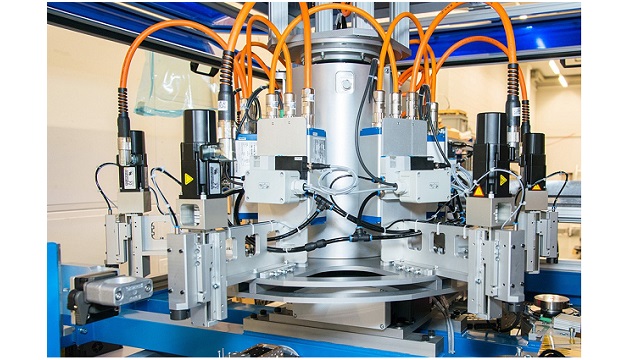Safe Torque Off (STO) in practice: a Swiss manufacturer of test equipment is already using the TÜV-certified safety technology based on a slip ring and AKD-N servo drives from KOLLMORGEN arranged in a distributed setup.
Slip rings emerged at the same time as electric motors and generators. The operating principle, which involves sliding contacts on rotating circular conductors, is essentially fairly simple. Any issues relate to matters of detail, and these are the things that currently present the main challenge to developers, with regard, for example, to the growing role of safety technology in the field of engineering.
Rotary indexing tables are a common piece of equipment used in an assembly and test stand context. Various work stations are arranged around an outer radius and take the component, held in a workpiece carrier, through another production stage with each indexing operation. If the workpieces on the rotating table still require rotational or linear positioning as well, the drives need to move as well.
Benefits of distributed servo technology
The idea behind the engineering project was to install not only the actuators but also the controls on the rotary indexing table, adopting a distributed arrangement to save space. The Kollmorgen solution to this task was to use AKD-N servo drives, in a distributed setup, and compact AKM synchronous servo motors with high power density.
The main benefits of the distributed setup and of having just one cable connecting drive and motor are small control cabinets and the fact that less space is required for installation purposes. In addition, the single cable connection technology, with the option to loop from drive to drive, also improved the inertia of the rotary indexing table. But it was still necessary to satisfy the safety technology requirements. This is integrated into the test station in the central AKD-C power supply module, which means a connection to the servo axes is required.
The Safe Torque Off (STO) feature was needed because the masses being moved, the rotary indexing table has a diameter of 120 cm after all, present a potential hazard to persons in the vicinity. The testing process does, however, envisage some operator intervention on the system, which ultimately implies Safe Torque Off as regards evaluating safety.
Safety in the slip ring, with a certificate
As part of the joint engineering project with the test stand builder, Kollmorgen began to look for a suitable manufacturer of slip rings who would be willing and able, together with the servo drive and motion control specialists, to develop a safety slip ring with TÜV certification. The current solution, approved by TÜV Süd, is based on a slip ring from the Bako LP range from Stemmann-Technik.
Interference-resistant communication of signals
Kollmorgen and Stemmann-Technik are able to combat the familiar problems associated with EMC through two separate measures. From a design perspective, two shielded junction boxes in the safety slip ring interrupt the Ethercat communication supply via which the superimposed safety signal is transmitted. This ensures in particular that the magnetic influences from harmonics in the power wires do not cause any signal interference. The second aspect for ensuring high resistance to interference within the slip ring relates to the structure of the safety signals. Compared with the standard practice of arranging STO with 5 or 24 VDC signals, Kollmorgen uses AC signals with specific frequency patterns between the AKD-C, as the central module, and the distributed AKD-N servo drives.
Conclusion
The new safety slip ring solution, developed jointly by Kollmorgen and Stemmann-Technik, means users do not have to miss out on the benefits of drive-based safety technology. Even for applications involving slip rings. So certification of STO in the slip ring paves the way for streamlined solutions for incorporating Safe Torque Off into applications involving rotation, including with innovative single-cable connection technology and servo drives arranged in a distributed setup. And as far as the US market is concerned, this solution would also retain UL certification.








